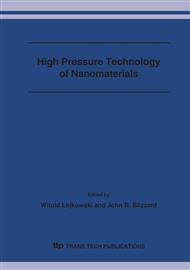p.79
p.85
p.91
p.97
p.101
p.109
p.117
p.123
p.133
Analysis of the Deformation Behaviour of Cu Processed by High Pressure Torsion
Abstract:
In the investigation the 3D version of the Estrin-Tóth dislocation model was used to analyze deformation behaviour of pure Cu, subjected to high pressure torsion (HPT) under pressures equal to 0.8, 2, 5, 8 GPa. As a result of the computer simulation, the nature and reasons for strain hardening are analyzed, the dislocation density evolution versus degree of SPD and graincell size versus degree of SPD curves were plotted. It is shown that the model adequately reflects the acting deformation mechanisms and structural changes during HPT at different applied pressures. It has been stated that an increase of the applied pressure at HPT leads to an increase in the activity of dislocation sources and sinks in the grain-cell walls. Misorientations between boundaries are estimated. It is revealed that an increase of the applied pressure contributes to a growth of the misorientation angles between neighbouring grain-cells.
Info:
Periodical:
Pages:
101-108
Citation:
Online since:
July 2006
Price:
Сopyright:
© 2006 Trans Tech Publications Ltd. All Rights Reserved
Share:
Citation:


